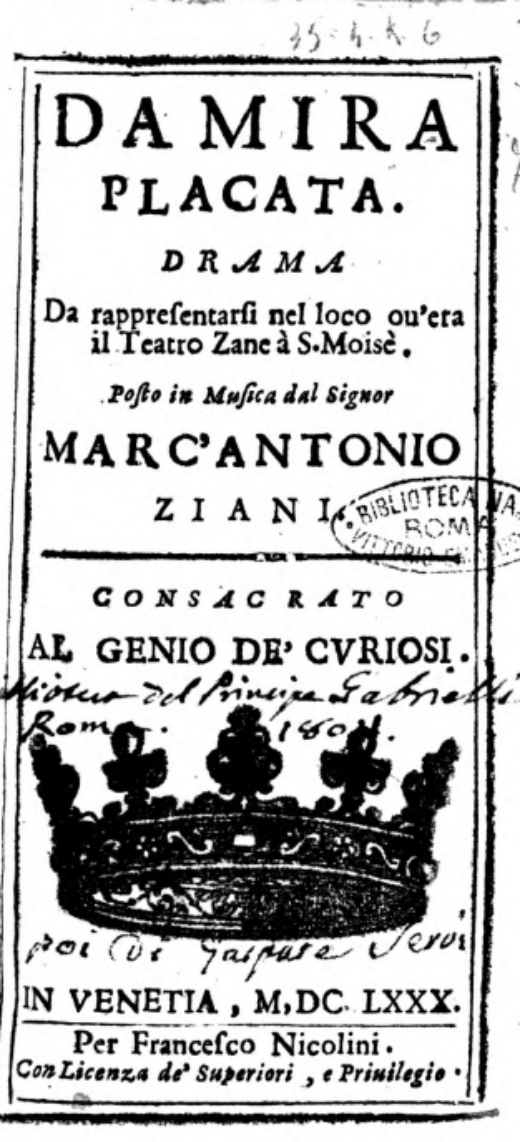
Printed
48 pages
Author(s)
Damira placata
From 1680 to 1682, as part of the Carnival, Venice hosts three seasons of puppet operas written by Acciaiuoli and performed at the Teatro San Moisè. The theatre has been partly dismantled, but a temporary stage is set up for the occasion. Acciaiuoli stages three drammi per musica on this stage, using large counterweighted figures animated from beneath the stage, while singers and musicians play behind the stage. Following Il Leandro, the first performance of this kind shown at Venice the previous year, these three plays – Damira placata, L'Ulisse in Feaccia, and Il Girello – help Acciaiuoli (whose name never appears in the libretti) win a learnt and aristocratic audience, that reads the texts in printed libretti handed out before the performances. These libretti give many indications about the musicians, set designs, machines and dances of the shows.
Acciaiuoli writes the text for Damira placata (Damira pacified), and Marc’ Antonio Ziani composes the music. The play is based on Le Fortune di Rodope e Damilar, a successful libretto by Aurelio Aureli, performed during the Venetian Carnival of 1657 at the Teatro Sant’ Apollinare, with music by Pietro Andrea Ziani. Acciaiuoli changes the names of the characters and focuses the play on Damira. The structure of the text is almost identical to that of Il Novello Giasone. The play alternates between pastoral scenes (focusing on the couple formed by Silo and Lerinda) and court scenes (focusing on Creonte and Fillide), with a few characters, such as Nerillo, bringing discreet comic elements. Damira, dressed as a shepherdess and calling herself Fidalba, brings these two worlds together. The action unfolds so as to highlight the technical virtuoso of Acciaiuoli’s puppets, which are articulated at the wrists, knees and ankles, and manipulated using a counterbalance system (which seems to be the system described by Sebastiano Serlio in 1663 in Architettura): this sophisticated mechanism is exploited fully in the dance of the Armenians at the end of Act I, or in the dance of madmen at the end of Act II. Indications related to it are also found in the stage directions from scenes such as the hunting scene (I, 4), in which Creonte alights from his horse to ask for water, after Silo entered the stage with an axe and a calabash filled with water; or when Nigrane draws his sword (III, 3). Damira placata is introduced as a performance showing “figure di nuova invenzione” (newly invented figures), an indication that attests to the novelty, for Venetian audiences in 1680, of Acciaiuli’s puppets. The play begins with a notice to the “Signori curiosi”, who are invited to admire the wonders of Art and the power of human genius, capable of bringing life to a piece of wood: puppets are proof that Art can accomplish what Nature cannot.
The score is one of the only remaining scores from this baroque Italian corpus for puppets. The music, created based on Venetian operas from the first half of the 17th century, alternates between melodic ariette and instrumental sonatas accompanied with dances. Maria de Martini puts on this version at the Teatro Domma in Rome in 2022, using large puppets and masks.
A woman tries to win back the heart of her husband, who sentenced her to death
Damira, sentenced to drown by her husband Creonte, king of Egypt, was saved by the fisher Silo, who took her in with his wife Lerinda to raise her as their daughter, changing her name to Fidalba. During a royal hunting game, Silo gives Creonte water from the Nile. To thank him, Creonte invites him to Court with his family. Fillide, the king’s favourite, has two lovers – Nigrane and Breno – but she hopes to marry Creonte. However, when the king promises that he will marry her, a painting of Damira falls to the ground: Creonte has an unfavourable premonition. Breno and Nigrane, pining for love together, realise that they love the same woman. Creonte discovers them and condemns them to exile. Damira comes back to Court, disguised as Fidalba, with Silo and Lerinda; Nerillo organises a dance of Armenians for them.
Fillide says goodbye to her two lovers. In the palace, Nerillo shows Fidalba a painting recounting Damira’s story, and he announces the wedding of Creonte and Fillide. The king welcomes Silo and Lerinda, and thinks he recognises their daughter as his ex-wife. Fillide tries to bring the wedding forward, but Fidalba interrupts her and announces that the king’s wife is still alive. While the young woman is thought to be mad, Creonte is plagued by remorse. Fillide overhears the end of his monologue and believes that she will be killed like Damira: she asks Breno to kill Creonte. Damira, hopeful, pretends to be mad. The act ends with a dance of madmen.
Breno tries to kill Creonte, who is sleeping by the Nile; Nigrane prevents him from doing so, but he is wrongly accused of trying to kill the king, and he is poisoned. To save him, Fillide gives him her clothes and has him leave with Nerillo. She gave Silo a golden chain to thank him for his good offices. Out of jealousy, Lerinda tries to take revenge on her rival and reports that she fled with Nerillo; Damira, wanting to take revenge, hits Nigrane, dressed as Fillide. Excused because Lerinda thinks she is mad, Damira reveals her identity and asks Creonte to pierce her breast: he is moved and decides to take his wife back. Creonte uncovers the veiled figure, Nigrane, and everyone reconciles – accusing Cupid, the blind god.
First performance
Teatro Zane à San Moisè
Publications and translations
Damira placata. Venezia: Francesco Nicolini, 1680.